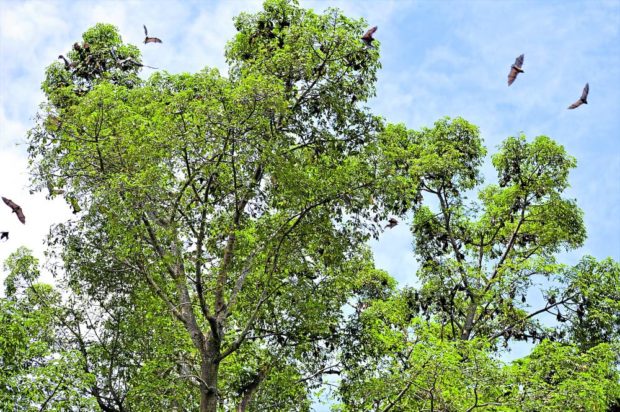
FLYING NEIGHBORS A colony of about 500 golden-crowned flying foxes, known among locals as “kabug,” has taken up residence at Barangay Poblacion in Catarman, Camiguin. Moves are now in place to protect them and their habitat. —JIGGER J. JERUSALEM
CAGAYAN DE ORO, Misamis Oriental, Philippines — Bats might have earned a bad reputation as among the suspected sources of the coronavirus strain that caused an infection in Wuhan, China, but tourism officials in one locality in Camiguin province want to tap their thriving bat community to be among the rare tourist attractions on the island.
Faced with the crippling effect of the pandemic on the local tourism economy, Camiguin opened to leisure travelers on Oct. 25 and continued to hatch projects—including letting them get acquainted with Catarman town’s bat population—to bring in more visitors, now that a swab test would no longer be required for fully vaccinated persons.
Locals in the sleepy Barangay Poblacion of Catarman town, first noticed the colony of bats hanging out in two gigantic trees since some eight years ago. The trees, identified by people here as “doldol,” or silk cotton tree, and “antipolo” trees, stand near the barangay road where houses cluster around a public market, grocery stores and dining outlets.
Local officials now think the flying mammals can be an added attraction on the island known for its white beaches, resort islands, springs, waterfalls, dive sites and other unique tourist drawers like the Sunken Cemetery.
Don Quililan, forest technician II of the Provincial Environment and Natural Resources Office (Penro) in Camiguin, said the bats in Catarman, called the golden-crowned flying foxes or “kabug” in Cebuano, were considered the country’s largest bat species, known to take up residence in trees.
“Judging from its size, a single bat could weigh from 400 grams to half a kilo,” said Catarman Mayor Kiterio Antonio Palarca II, who eyed the potential of the bat colony as a rare tourist attraction.
“In my travels around the country, I’ve seen a populous colony [of bats] only in Subic. But what makes our bats here in Catarman different is that they live in the middle of a human community. That is why we have to protect them,” Palarca said.
The Penro estimated more than 500 bats in the colony in Poblacion although residents recalled there were only 200 bats when the colony first came to settle. “Over the years, their population almost tripled in size,” said Tony Longay, a resident.
Safe and protected
It remained a puzzle for residents why the bats chose to live in a populated area like their place rather than in Camiguin’s forests. “Maybe, they like it here because people don’t hunt animals. Perhaps they feel safe and protected,” Longay said.
Quililan warned that killing a critically endangered animal such as the kabug would be punishable by law. He cited Republic Act No. 9147, or the Wildlife Resources Conservation and Protection Act of 2001, which penalizes offenders with a fine of P1 million to P2 million.
The mayor said the municipal legislative council had begun crafting an ordinance that would declare the colony’s habitat as a protected sanctuary.
“To ensure that the bats will stay put, we have to see to it that aside from prohibiting loud noises, the trees where they live must never be cut down nor their branches trimmed,” Palarca said.
He said the bats’ food of choice included mango, nuts from “talisay” (tropical almond) trees, “lanzones” and other wild fruits abundant on the island.
Owing to the island’s fertile volcanic soil, the lanzones in Camiguin has been touted as the sweetest among the varieties in the country.
“We have a mango tree near the municipal hall and whenever there are ripe fruits, the bats help themselves to these, which is a good thing because the ripe ones no longer fall to the ground,” Palarca said.
Palarca said residents had been made aware of the bats’ presence and that whenever he noticed the bats flying out in the middle of the day, he would often send the police to check if someone had disturbed them.
“The bats’ presence in Poblacion is living proof that we are protecting our environment. Imagine, they chose to live among people than in the wilderness,” he added.
View deck
He said the local government of Catarman planned to build a view deck a few hundred meters away from the colony’s dwelling place, where tourists could observe the bats from a safe distance.
“We will make the bats a tourist attraction without disrupting their habitat. We will buy telescopes for viewing,” Palarca said.
The Penro has also been conducting information drives to inform the residents that the golden-crowned flying fox is a critically endangered species because of its fast decreasing population.
“We, in Camiguin, are indeed blessed with diverse flora and fauna, thanks to our people’s vigilance and care for the environment,” said Camiguin Gov. Jurdin Jesus Romualdo. “These bats will become an added attraction to our island’s tourism industry. Now, our guests, especially environmentalists and wildlife lovers, will have more reason to visit Camiguin.